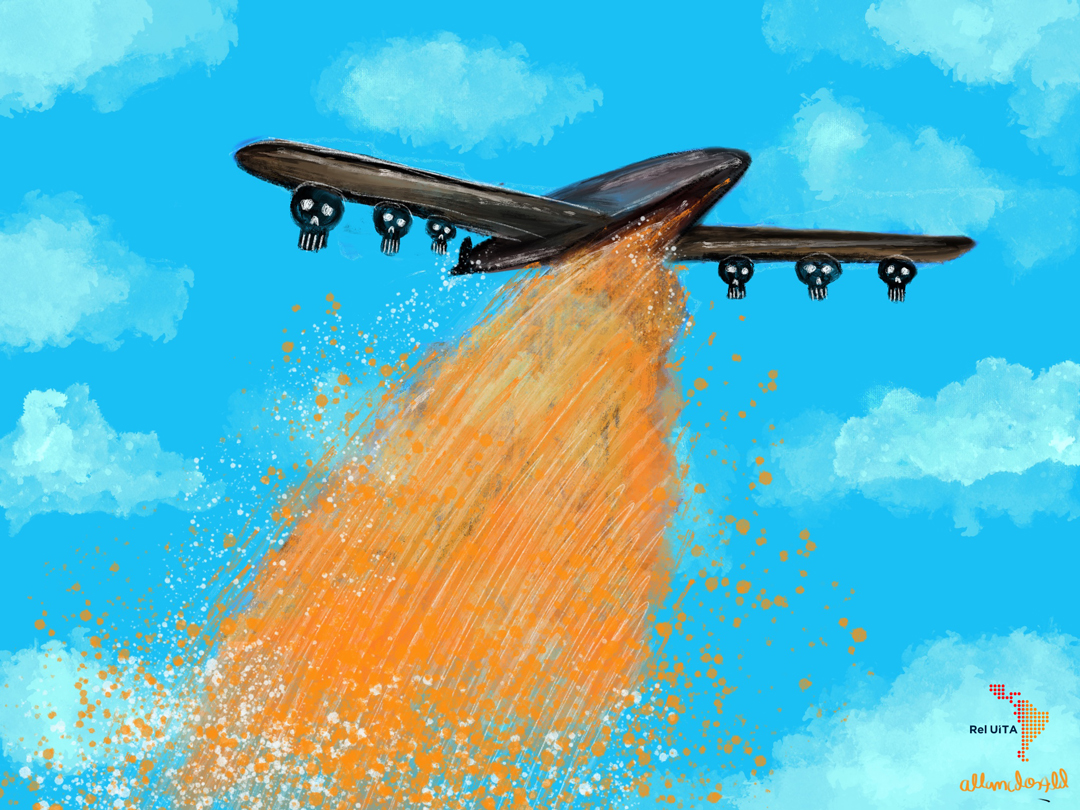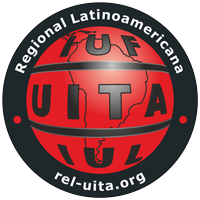France-United States-Vietnam | HEALTH | HR
Trân Tô Nga and her fight against 14 multinational manufacturers of Agent Orange
Daughter of a poisoned land
At almost 79 years of age, Trân Tô Nga says she is fighting “the” battle of her life: trying to hold 14 multinational corporations accountable for the use of “Agent Orange” during the Vietnam War, which destroyed her body and life, and the bodies and lives of many of her fellow nationals. The court action she brought against these corporations in 2014 in France is now in its final stage.
Daniel Gatti

Illustration: Allan McDonald
From 1962 to 1973, the United States poured tens of millions of liters of chemical agents over Vietnam.
The openly declared objective was to rob Viet Cong fighters of hiding places in the jungle and in rural areas. The attacks with these chemical weapons affected millions of people, both directly and indirectly. Many of them died over the following years. Others have suffered horrendous diseases. But not just them, their descendants as well.
Millions of hectares of fertile land were also scorched and the farmers in the sprayed areas lost their livelihoods. Not only was it a war crime, it was ecocide.
In an official U.S. report issued in 2003, chemist Jeanne Stellman estimated that between 2.1 and 4.8 million people were directly affected by the chemical weapons used by her country in Vietnam.
According to André Bouny, a French writer who has been studying this issue for years and has published solidly documented books on it (including Agent Orange: Apocalypse Vietnam), the figures in the “Stellman report” are a very modest estimate. He says that “at least” 5 million were directly affected and that the United States sprayed much more poison over Vietnam than it admits to.
Bouny heads the International Committee for the Support of Vietnamese Victims of Agent Orange, one of the organizations that has made it possible to deliver some measure of help to tens and tens of thousands of people who even today are born in Vietnam “with features that defy the generic morphology of the human species” and who survive isolated, receiving almost no care, because they “bring shame” even on their families, the vast majority of whom are poor peasants.
Five decades after it ended, the Vietnam War is still killing and will continue killing, Bouny says.
Hence the importance, among other things, of the claim filed in 2014 by Trân Tô Nga, the first direct civilian victim of U.S. spraying to succeed in putting the companies responsible for manufacturing these products in the dock.
“Agent Orange,” which got its name from the orange stripe on the drums in which it was transported, accounted for 62 percent of all the defoliants sprayed from U.S. Air Force helicopters and planes during the Vietnam War, the Stellman report notes.
This is not just any substance: the World Health Organization has listed it among the worst poisons that exist and classified it as “highly carcinogenic” in humans, as has the United States Department of Health itself.
Two herbicides—2,4-D and 2,4,5-T—are combined to make this agent, and a dioxin called TCDD is added to the 2,4,5-T, making the substance particularly harmful.
Scientific studies have found that in addition to cancer “Agent Orange” causes alterations to embryonic and fetal development and can modify cellular DNA, being passed down from generation to generation through the food chain. It can remain in the environment for up to one hundred years.
“I am a daughter of the Mekong, colonialism, and war. I am a daughter of a magical and poisoned land,” Trân Tô Nga wrote in her autobiography Ma terre empoisonnée (My Poisoned Land), published in France in 2016.
Born in the south during the Indochina War, in which her parents joined the resistance to French colonialism, she came of age in a country torn in two. She grew up in the liberated north, where her family had sent her for her own protection. But when she was still very young she went back to the south to fight against the U.S. invader.
She fought with weapons and with words, as she became a journalist.
In her book she recalls in detail the moment she was sprayed for the first time by a U.S. C-123 flying at low altitude, leaving “a white stain in the blue sky” and on her body “a sticky rain.”
Her mother screamed, horrified, telling her to take her clothes off and wash immediately. She did as she was told, but did not give much importance to it. “What could the spraying of a simple herbicide do in the middle of the apocalypse that was engulfing our beloved Vietnam in flames? (…) Yet, it was with that toxic shower that the bad took root inside my body,” she wrote.
Some months later she was again victim of a new fumigation when, as a journalist, she went “to the most dangerous places on the front” to report on what was happening.
It was 1966 and she was still barely 24. From that year on she suffered all kinds of pathologies. It was not until the 2000s, however, that she began to suspect that all those illnesses could be connected to that “herbicide” that was sprayed from the sky.
It was too much of a coincidence that her daughters and granddaughters should have similar health problems. Her first daughter had died in 1969, when she was less than eighteen months old, due to a heart malformation, which her other two daughters also have, in addition to bone, skin, and other conditions.
According to the Paris weekly Politis, in a piece on Nga published in January, the scientific literature she read when she was already living in France and the accounts she had access to gradually convinced her that she had to do something.
A visit in 2008 to one of the camps where direct and indirect victims of Agent Orange survive was decisive in that realization. There she saw “teenagers missing hands and legs, deformed babies, and individuals whose age” and features were unrecognizable.
“Scientific studies are still being conducted today throughout the world to irrefutably prove how the effects of Agent Orange have been passed down to the third, and even fourth, generation,” Politis notes.
In 2011, Nga had blood work done in a German laboratory.
Her toxin levels were found to be significantly higher than average, she had developed subcutaneous nodules, and she was diagnosed with diabetes, chloracne, a genetic hemoglobin disorder, and a heart malformation, all pathologies that in 1996 the U.S. National Academy of Sciences had listed among the 17 pathologies caused by exposure to Agent Orange.
In 2014, she filed a lawsuit against the manufacturers of the poison in a court in Evry, a Paris suburb in the jurisdiction in which she lives.
The “preliminaries” took six years. These included the filing of documentation and multiple attempts by the companies’ defense lawyers to block the process and question the jurisdiction of French courts in the case.
This year, on January 25, the trial entered its final stage, with both sides presenting their arguments. Nga’s defense team is made up of just three lawyers, who are up against a whole army of litigators representing the companies.
The plaintiffs first tried to sue 26 U.S. multinational corporations that operated in the agrochemical sector in the 1960s. That number was cut almost in half, as for some of those companies no relationship with the manufacture of Agent Orange could be proven, and others simply disappeared.
Among the 14 that were effectively brought to trial are Dow Chemical, Uniroyal, Occidental Chemical, TH Agriculture, and Bayer, Monsanto’s current owner.
Some of these companies have already faced lawsuits in the past. But those actions were all brought by U.S. veterans or by South Korean veterans, who—like Australians, Canadians, New Zealanders, Thais, and Filipinos—fought alongside the U.S. invaders and were also poisoned.
In the United States, in 1984 Judge Jack Weinstein ordered Monsanto and six other agrochemical manufacturers to pay these veterans some 180 million dollars for damages to their health.
Shortly after, however, that same Judge Weinstein denied the Vietnamese Association for Victims of Agent Orange (VAVA) the right to file a lawsuit. He considered that the Vietnamese had no “legal basis” for litigation. A court of appeals upheld that decision and the Supreme Court then closed the door to VAVA’s ever filing suit.
In South Korea, two multinational corporations, Monsanto and Dow Chemical, were sentenced by a court to compensate the war veterans who filed suit. However, as a result of U.S. diplomatic pressures, they never saw a dime, Politis reports.
According to Politis, the companies have three lines of defense: they claim that they are not responsible for any damage done because they were obeying orders from the United States government in wartime; that they were unaware of the effects of “Agent Orange” on human health; and that Trân Tô Nga cannot prove that her current illnesses, or that of her descendants, have anything to do with this defoliant.
One of the lawyers representing Monsanto-Bayer went so far as to say that this and the other companies, “were performing a public service” for their country at war and that they could not say no to the patriotic effort that they were being asked to make.
“No war can justify the use of chemical weapons,” William Bourdon, one of Trân Tô Nga’s lawyers, said. He also brought to light official documents that showed that the U.S. governments of the time (the John F. Kennedy, Lyndon B. Johnson, and Richard Nixon administrations), however criminal they may be accused of being, did not force the companies to produce “Agent Orange.” Rather they opened a bidding process and the agrochemical companies rushed en masse to offer their poisons when they saw how profitable the business was.
“You don’t need to have memorized Karl Marx’s Capital to know that the logic of profit leads big business to lie. There was no military requisition, but rather a bidding process, and the companies responded as one, as an organized band,” the lawyer said.
“They are just as responsible as the government,” he added.
Another of Nga’s lawyers, Amélie Lefebvre, proved that Monsanto’s executives knew the level of toxicity of “Agent Orange” before it was sprayed on the Vietnamese people, because they had had to compensate their own workers who had been contaminated while manufacturing the substance.
“That was kept secret. The companies closed ranks to prevent this from coming out and causing a scandal, because they knew they had a very lucrative and sure market: the U.S. military,” Lefebvre said.
Over time, the secret came out and the evidence against the companies—and against the United States, but that would be the subject of another, less “winnable” lawsuit— kept mounting at every level.
The ruling is scheduled to be handed down on May 10.
“Hopefully the band will be convicted,” Bourdon said. “If we succeed, we will be setting a precedent in favor of the victims and also of universal justice in crimes against humanity.”
And there is another probable “historical” dimension to this trial, which is highlighted by the Vietnam-Dioxin Collective, formed by a dozen associations and labor federations that are behind this lawsuit. Nga’s potential success would establish “new case law that could be cited by all victims of chemical weapons and pesticides,” including those of other poisons, such as glyphosate-based agrochemicals, another of Monsanto’s great inventions, which continues to be sprayed on fields around the planet, especially in Latin America.
The Vietnam-Dioxin Collective is formed by several of the associations that in recent years have led the fight in France against the U.S. multinational corporation absorbed by Bayer.
